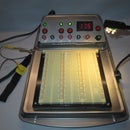Introduction: Sliding Door Secret Compartment
The door is driven by a continuous rotation servo motor with a pulley system. There are two hidden push buttons that control the servo motor rotation. Inside the enclosure there is a Normally Open mini contact switch (NO), and 5 LEDS . As the door slides open the switch goes from normally open to close state, turning the LEDS ON. When sliding door closes, it turns the LEDS OFF, by changing the contact switch back to N.O state.
The circuit is a typical and simple servo motor driver/tester, using the 555 IC timer. This circuit works great with continuous rotation servos. I built this project using whatever parts were handy and available that I could use at the time it was built.
There are a lot of features you can apply to this project, for example using a microcontroller like the Arduino to control a motion sensor, Clapping sensor, Wireless Remote, a camera that text you pictures when the door is been open, use an entry key pad code to activate the door. There are a lot of things you can add to this project, to make it more of a spy kind of gadget.
Step 1: Material List
- Plastic pulley set (eBay or Hobby store)
- Big continuous rotation servo motor
- Jumper wires
- Small breadboard
- (1) 4AA Battery holder
- (4) AA Batteries
- (2) Small push button switch
- (1) Mini contact switch
- Light or LEDS
- Male pin headers
- 555 IC timer
- (1) BC547 transistor
- Resistors: 1K, 68K, 33K, 10K and 47K.
- Small 1/2" wood screws
- wood glue
- 1/4" x 2' x 4' poplar hobby board (home depot)
- Michaels store: small storage box 12" x 9" x 3 1/8", (2) Balsa 1/8" x 8" x 3" sticks.
Step 2: Enclosure
Take the storage box and the first thing you are going to do is to remove the back cover. We need access to install the motor and pulley assembly. Be very careful not to break the board or the frame. Save the back board, you'll need it later (see pix 1,2 and 3). Take the balsa stick and cut them to the inside measurement of the upper and lower side of the enclosure and glue them at 3/16" from the front edge of the enclosure (see pix 4, 5, 6 and 7). This pieces will keep the picture from falling back into the enclosure.
Remove at about 1/4" from one of the side pieces of the fame. This will give the door cover enough clearance to slide open/close.
Now grab the 1/4" x 2" poplar hobby board and cut it to form the outside picture frame (see pix 8,9,10 and 11). Make sure the outside frame is 1/4" shorter all around the inside of the enclosure, this will keep the picture in place and with the balsa sticks previously glued will form a channel that will allowed the picture to slide open/close (see pix 12, 13 and 14). Glue the upper, lower and left side of the outside picture frame on the front side of the enclosure. Now cut the plastic board to fit the inside of the enclosure, make sure you cut it at about 1/8" shorter vertically and 1" longer horizontally . Slide it in to the enclosure. Grab the right piece of the picture frame and glue it to the plastic board and test it, make sure it slides in and out freely (see pix 15,16 and 17).
Step 3: Sliding Door Pulley Sysytem
Install the biggest pulley centered on the right side of the sliding door. (looking at it from the back). Then place two small screws on the opposite side of the big pulley ( on the wood frame) at about 3" from the top and place second screw 4 1/2" below the first screw.
Notice the position of the tensioner pulley and servo motor, no matter where you decide to place them, they have to be in the position shown in the pictures with enough tension in order to work. The string has to have that "S" shape around the motor and tensioner so the motor can pull the string, otherwise the motor will just be spinning and not opening/closing the door.
Once the tensioner is in place, tie one end of the string to the upper screw and wrap it around the tensioner pulley, around the big pulley and tie the other end on the bottom screw. ( leave a little slack for the motor). Now here is the tricky part, wrap the string around the motor pulley and put tension on the string by pulling the motor away from the tensioner pulley and once you have good tension on the string (do not let go) screw the motor in place with out loosing the tension on the string. (See pix 1, 2, 3, 4 and 5)
Step 4: Circuit, Contact Switch and LEDS
Now is time to install the LEDS, contact switch and assemble the servo motor controller circuit. This has to be done at this point, so you can test the pulley system and to make sure that the door slides open/close freely. Install the LED lights and contact switch. The contact switch should be placed on the upper right corner of the enclosure, cut a small piece of plastic board glue it to the plastic board so when the door slides close, it makes contact with the switch (see pix 1, 2, 3, 4 and 5).
Now look at picture 6 , it shows how to wire the light and switch. You are going to make an extension to the switch, light and servo motor an run the wires through the wall to the circuit board. Look at the video below, it shows the motor and pulley system working from the inside of the enclosure. Last step run the servo motor wires, LEDS wires and contact switch through the top peace of the enclosure.
Step 5: Hang Picture Frame
Now is time to hang the "picture frame on the wall".
Before cutting your wall, check for the stud location. They are usually 16" center to center apart from each other, your enclosure should fit between studs. Trace the back of the enclosure on the wall and cut the opening 1/8" bigger than the enclosure. before installing the enclosure, run the wires through the wall first, then install the enclosure. Drill a hole in the center of the picture frame top piece, this will be use to attach the enclosure in place ( just like hanging a picture on the wall).
NOTE: While installing the enclosure in the wall, I noticed that I could not place the enclosure flat to the wall. The door will not slide open, It need it at about 3/16" clearance from the wall to the frame. To fix this glue a piece of 1/4" x 1/2" of hobby wood to keep a 1/4" clearance. This worked, the door slide open with out any issues. (see pix 1, 2, 3 and 4).
Step 6: Conclution
This project took me about 31/2 hrs. from start to finish. I wanted to build something simple and at the same time useful. I was running out of time to enter into the secret compartment contest, I could not get any idea of what to make, I wanted something unique and different from other projects in this contest. Finally I came up with this project and it was fun to build.
Good Luck

Participated in the
Supercharged Contest

Participated in the
Secret Doors and Compartments Contest














